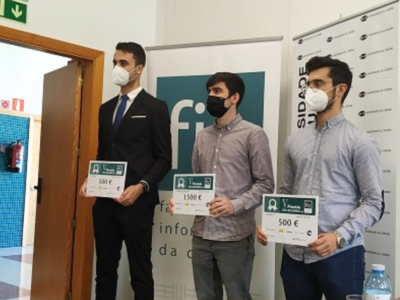The event took place on October 30, 2020, at the Faculty of Computer Science of the UDC. It turned out to be a different edition, but with six high-caliber projects. The event is sponsored by the ALDABA WIB Chair: Women, ICT & Business, Balidea, Corunet, Everis, and Grupo Voz, in collaboration with CITIC and the University of A Coruña Foundation.
The best final degree projects defended during the 2018/19 academic year were recognized, with the Jacobo Fiaño Salinas First Prize being awarded. The runners-up were Roi Galego Torreiro and Roberto López Castro.
The finalists were the works of David Otero Freijeiro, Sergio Rodríguez Gayoso, and Arturo Silvelo Pallín. Although they did not win any awards, they presented works of great quality.
Jacobo Fiaño Salinas won the First Prize for Best Applied TFG at the FIC, along with €1,500, for his project: “Development of an application to determine the most suitable recipient for a kidney transplant,” as it is a support tool that physicians at the University Hospital of A Coruña can use. This is a contribution of utmost importance, since at present there is no tool with a similar purpose that can be used by physicians and that streamlines collaborative work in the medical sector.
Roi Galego Torreiro was awarded one of the two €500 Accésit prizes for his work: "Development of a tool for quality control of genetic sequences in Big Data environments." The target users of this application are primarily biologists, bioinformaticians, and scientists who need to process large amounts of genomic sequences to obtain datasets they can work with that meet the appropriate quality standards or are tailored to their needs. Thanks to the performance improvements SeQual offers over other similar tools, data processing time is drastically reduced.
Roberto López Castro was awarded another of the €500 runner-up prizes for his work: "Use of computer vision techniques for tracking individuals at sporting events." Individual tracking of an athlete during a sporting event is of great interest to coaches, physical trainers, fans, and the media. The primary target users of this work can be divided into two main groups: soccer teams (coaching staff and personnel involved in player preparation) and the media.
David Otero Freijeiro, finalist for the work: “Platform for the assisted labeling of early-risk cases on the Internet.” According to the WHO, in one of its latest publications on adolescent mental health, one in six people with mental disorders is between 10 and 19 years old. It is well known that language is a significant indicator of people’s emotional state and, therefore, helps in the detection of these disorders. Using these indicators for the early detection of such risks has proven to be a very fruitful line of research.
Sergio Rodríguez Gayoso, finalist for the work: “Android device and application to enhance cycling safety.” Nowadays, bicycle trips, especially in cities, are experiencing a notable increase. The coexistence of these vehicles with cars entails a high risk of injury in the event of an accident. To try to improve this situation, this project sought to create a system to enhance both the user’s visibility and their visual perception. The objective of this work was to study, design, implement, and subsequently evaluate a system composed of a camera and lights to improve cyclists’ safety on public roads.
Arturo Silvelo Pallín, finalist for the work: “Bachelor’s Degree in Computer Engineering.” Since the dawn of computing, authentication models have been an essential component of information security. For the analysis of this information, various artificial intelligence techniques were employed to develop a set of algorithms that would enable the generation of individual profiles for user identification, allowing identification not only at login but also in real time. Among the possible applications, one is currently under development for the banking sector, as it allows verification of whether unauthorized transactions, such as a transfer, are being carried out.



